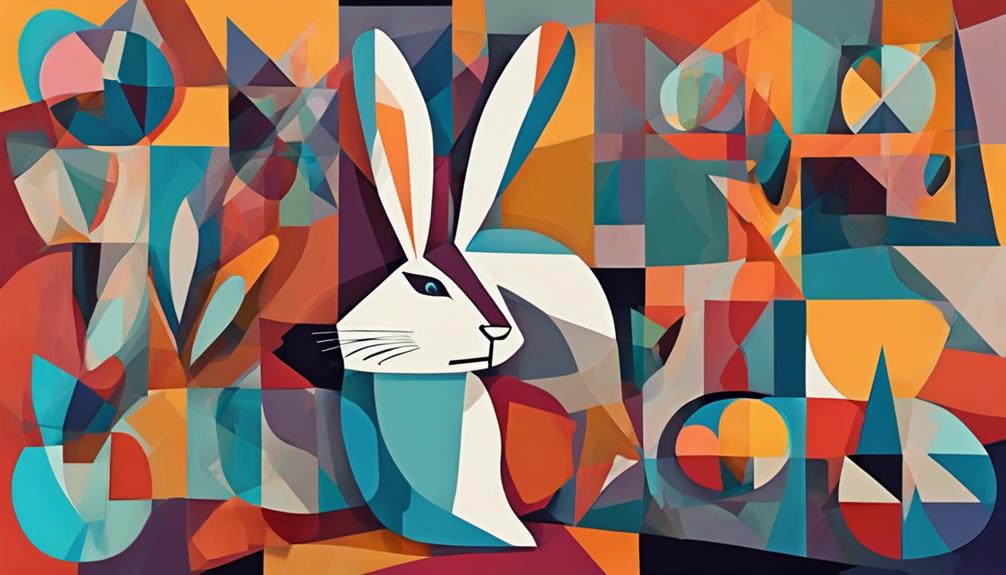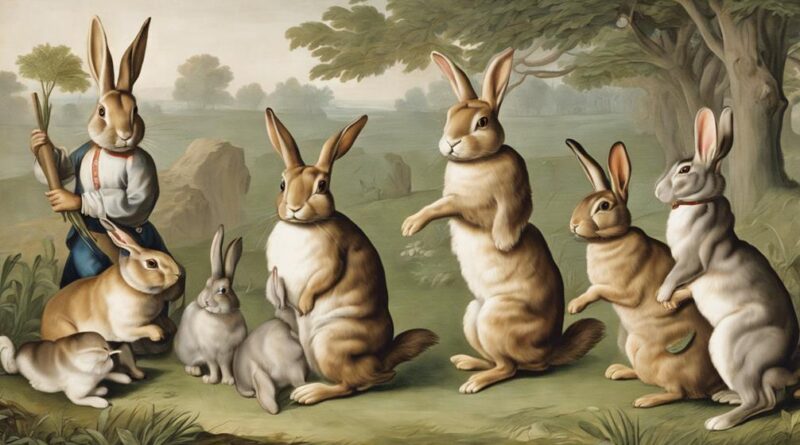7 Best Depictions of Rabbits in Historical Art
Discover the timeless allure of rabbits in art with these masterpieces: Ancient Egyptian Hieroglyphs symbolizing fertility and rebirth, Albrecht Dürer's realistic and philosophical Hare painting, Japanese folklore art embodying fertility and good fortune, intricate Chinese Moon Rabbit sculptures in jade and wood, the emotional depth of The Velveteen Rabbit illustrations, medieval European depictions exuding innocence and rebirth, and Pablo Picasso's modern twist on rabbit symbolism with bold lines. Unravel the layers of symbolism and artistic mastery in each of these captivating rabbit depictions.
Ancient Egyptian Rabbit Hieroglyphs
When studying Ancient Egyptian hieroglyphs, one can't overlook the significance of rabbit symbols and their representations in various contexts. Rabbits held a prominent place in ancient Egyptian culture, symbolizing fertility, rebirth, and agility. These creatures were often depicted in petroglyphs, carved into rock surfaces, showcasing their importance in religious and everyday life. The rabbit symbolism was deeply intertwined with the concept of regeneration and the cycle of life and death in Egyptian beliefs.
Ancient petroglyphs featuring rabbit symbols weren't merely decorative but held profound meaning. The rabbits were often depicted alongside symbols of the moon, connecting them with lunar cycles and the passage of time. This association emphasized the role of rabbits as creatures embodying the cyclical nature of existence, much like the phases of the moon.
Moreover, the agility and speed of rabbits translated into symbolism related to quick thinking and swiftness in decision-making. In a society where survival often depended on wit and resourcefulness, these attributes were highly valued. The intricate details in which rabbits were portrayed in ancient petroglyphs reflect the meticulous observation and reverence the Egyptians had for these animals.
The Velveteen Rabbit Illustrations
The illustrations accompanying 'The Velveteen Rabbit' exemplify a timeless charm that enhances the emotional depth of the narrative. The Velveteen rabbit symbolism is vividly portrayed through the delicate strokes and warm colors used in the illustrations. Each image captures the essence of the story, bringing to life the beloved characters and evoking a sense of nostalgia and innocence in the viewers.
Moreover, the detailed rabbit anatomy study depicted in the illustrations adds a layer of authenticity to the characters. The artist's attention to the physical features of rabbits, such as their whiskers, fur texture, and expressive eyes, helps readers connect more deeply with the protagonist, the Velveteen Rabbit. By accurately portraying these anatomical details, the illustrations create a sense of realism that grounds the fantastical elements of the story in a relatable context.
Albrecht Dürer's Hare Painting
In exploring depictions of rabbits in historical art, a notable piece that stands out is Albrecht Dürer's Hare painting. This masterpiece is renowned for its realistic portrayal, captivating viewers with its striking realism and meticulous attention to detail. Painted in 1502, the artwork showcases Dürer's exceptional skill in capturing the essence of the hare with astonishing accuracy. The fur texture, the delicate features, and the lifelike expression of the animal all contribute to the painting's remarkable sense of realism.
Dürer's Hare painting isn't merely a study of a hare; it also holds symbolic meaning. During the Renaissance period, hares were often associated with various symbolic interpretations, including fertility, rebirth, and agility. In this context, Dürer's depiction of the hare goes beyond a simple representation of the animal; it serves as a reflection of deeper philosophical and cultural ideas prevalent during that time.
The choice of subject matter and the meticulous execution of the painting demonstrate Dürer's commitment to portraying the natural world with unparalleled precision. Through his Hare painting, Dürer invites viewers to appreciate the beauty of the animal world while also delving into the rich symbolism associated with the hare in historical and cultural contexts.
Japanese Rabbit Folklore Art
Exploring Japanese Rabbit Folklore Art reveals a rich tapestry of cultural symbols and narratives intertwined with the graceful and mystical portrayal of rabbits. In Japanese rabbit folklore art, symbolism plays a crucial role in conveying deeper meanings. The rabbit is a popular symbol in Japanese culture, often associated with qualities like fertility, longevity, and good fortune. These symbols are intricately woven into the art, creating a visual language that resonates with viewers.
Techniques employed in Japanese rabbit folklore art are diverse and skillfully executed. Artists utilize a variety of mediums such as painting, woodblock prints, and ceramics to bring these mythical creatures to life. One of the most famous instances of Japanese rabbit folklore art is the story of the Moon Rabbit, where a rabbit is said to be pounding rice cakes in the moon. This narrative has inspired numerous artistic interpretations over the centuries, each capturing the essence of the tale through different techniques and styles.
Japanese rabbit folklore art not only showcases the artistic prowess of the creators but also serves as a window into Japan's rich cultural heritage. The intricate symbolism and masterful techniques employed in these artworks continue to captivate audiences, offering a glimpse into the mystical world where rabbits are more than just animals—they are bearers of tradition, symbolism, and enchantment.
Chinese Moon Rabbit Sculptures
Amidst the rich tapestry of cultural symbolism in Asian art, Chinese Moon Rabbit sculptures stand out as exquisite manifestations of myth and craftsmanship. These sculptures, deeply rooted in Chinese folklore and mythology, often depict rabbits gazing at the moon, embodying the lunar symbolism prevalent in Chinese culture. The Moon Rabbit, also known as the Jade Rabbit, is a significant figure in Chinese folklore, believed to reside on the moon, pounding herbs to make the elixir of life.
The artistic craftsmanship displayed in Chinese Moon Rabbit sculptures is truly awe-inspiring. Artisans meticulously carve intricate details into various mediums like jade, porcelain, and wood, capturing the essence of these mythical creatures. Each sculpture is a testament to the skill and dedication of the craftsmen who bring these folklore-inspired creations to life. The delicate features of the rabbits and the serene expressions on their faces evoke a sense of tranquility and mystique.
Chinese Moon Rabbit sculptures not only serve as artistic masterpieces but also as cultural artifacts that highlight the deep-rooted connection between Chinese folklore and artistic expression. The blending of lunar symbolism with artistic craftsmanship in these sculptures creates a mesmerizing visual representation of the mythical world, inviting viewers to delve into the rich tapestry of Chinese mythology and tradition.
Medieval European Rabbit Manuscripts
Crafted with meticulous detail and often adorned with intricate illustrations, Medieval European Rabbit Manuscripts offer a glimpse into the artistic and cultural world of the Middle Ages. These medieval manuscripts, originating from various regions in Europe, depict European rabbits in a variety of contexts, showcasing the significance of these animals in medieval society.
In these manuscripts, European rabbits are commonly portrayed in naturalistic settings, such as meadows or forests, reflecting the medieval fascination with the natural world. The rabbits are meticulously illustrated, capturing their distinctive features such as long ears, fluffy tails, and often a sense of agility or playfulness. Artists of the Middle Ages paid close attention to the anatomy of the rabbits, striving to depict them accurately while infusing a touch of artistic flair.
Moreover, European rabbit manuscripts sometimes featured allegorical representations, where rabbits were used symbolically to convey moral, religious, or social messages. These symbolic depictions added layers of meaning to the artworks, inviting viewers to contemplate the deeper significance behind the portrayal of rabbits in medieval European art.
Pablo Picasso's Bunny Drawings

Have you ever delved into the captivating world of Pablo Picasso's Bunny Drawings, exploring the unique artistic vision of this renowned master? Picasso, known for his revolutionary contributions to the art world, also left a mark with his endearing depictions of bunnies. These whimsical and charming drawings showcase Picasso's influence in the realm of animal symbolism.
Picasso's Bunny Drawings aren't just simple sketches of rabbits; they delve deeper into the realm of symbolism. Bunnies, in art history, have often represented fertility, rebirth, and innocence. Picasso's interpretation of these creatures adds a layer of complexity to their traditional symbolism. Through his bold lines and abstract forms, Picasso transforms the humble bunny into a symbol of creativity and playfulness.
Picasso's influence on the art world is undeniable, and his Bunny Drawings are a testament to his ability to infuse even the simplest subjects with profound meaning. The way he captures the essence of these creatures with minimalistic yet expressive lines is truly remarkable. Each bunny seems to dance off the page, exuding a sense of joy and light-heartedness that's quintessentially Picasso.
Frequently Asked Questions
What Inspired the Artists to Depict Rabbits in Historical Art?
When artists depicted rabbits in historical art, they were often inspired by the symbolism associated with these creatures. Rabbits are commonly seen as symbols of fertility, rebirth, and agility. Artists used these symbolic meanings to convey deeper messages or themes in their artworks.
The artistic inspiration behind including rabbits in historical art varied from culture to culture, but the recurring themes of vitality and renewal were prevalent in many depictions.
Are There Any Hidden Meanings or Symbolism Behind the Rabbit Depictions?
When exploring the symbolism behind rabbit depictions in historical art, you'll find a range of interpretations. Artists often used rabbits to symbolize fertility, innocence, or even trickery.
The choice to include rabbits in their art was deliberate and added depth to their work. Understanding the artistic interpretations behind these creatures can offer insight into the themes and messages conveyed in the artwork, enriching the viewer's experience.
How Did the Artists' Techniques Evolve in Portraying Rabbits Over Time?
As artists honed their skills, the evolution of techniques in portraying rabbits became evident. Initially, simplistic and symbolic representations gave way to more intricate and realistic portrayals. This shift was influenced by various factors, such as advancements in artistic inspiration and a deeper understanding of anatomy.
Artists began to capture the essence of rabbits with greater precision, showcasing their movements, expressions, and habitats in a more lifelike manner.
Were Rabbits Considered Sacred or Special in Any of the Depicted Cultures?
Rabbits were indeed considered sacred animals in various cultures, with many folklore connections. These furry creatures often symbolized fertility, luck, and abundance.
In some societies, they were associated with deities or seen as messengers between the earthly and spiritual realms. The reverence for rabbits can be traced back through different historical artworks, showcasing their significance in ancient beliefs and traditions.
Did the Artists Have Any Personal Connections to Rabbits in Their Lives?
When creating their masterpieces, artists often drew inspiration from personal connections to their subjects.
Rabbits, with their symbolism of fertility and playfulness, could have resonated with the artists on a deeper level.
Whether they kept rabbits as pets, admired them in nature, or simply found the animals intriguing, these personal connections likely fueled the artistic inspiration behind the depictions of rabbits in historical art.
Conclusion
Overall, the depictions of rabbits in historical art offer a fascinating glimpse into the cultural significance of these creatures throughout different time periods and regions. From ancient hieroglyphs to modern illustrations, rabbits have been portrayed in various styles and contexts, reflecting both their symbolic meanings and aesthetic appeal.
Each artwork provides a unique perspective on the rabbit, showcasing its versatility as a subject in the world of art.
